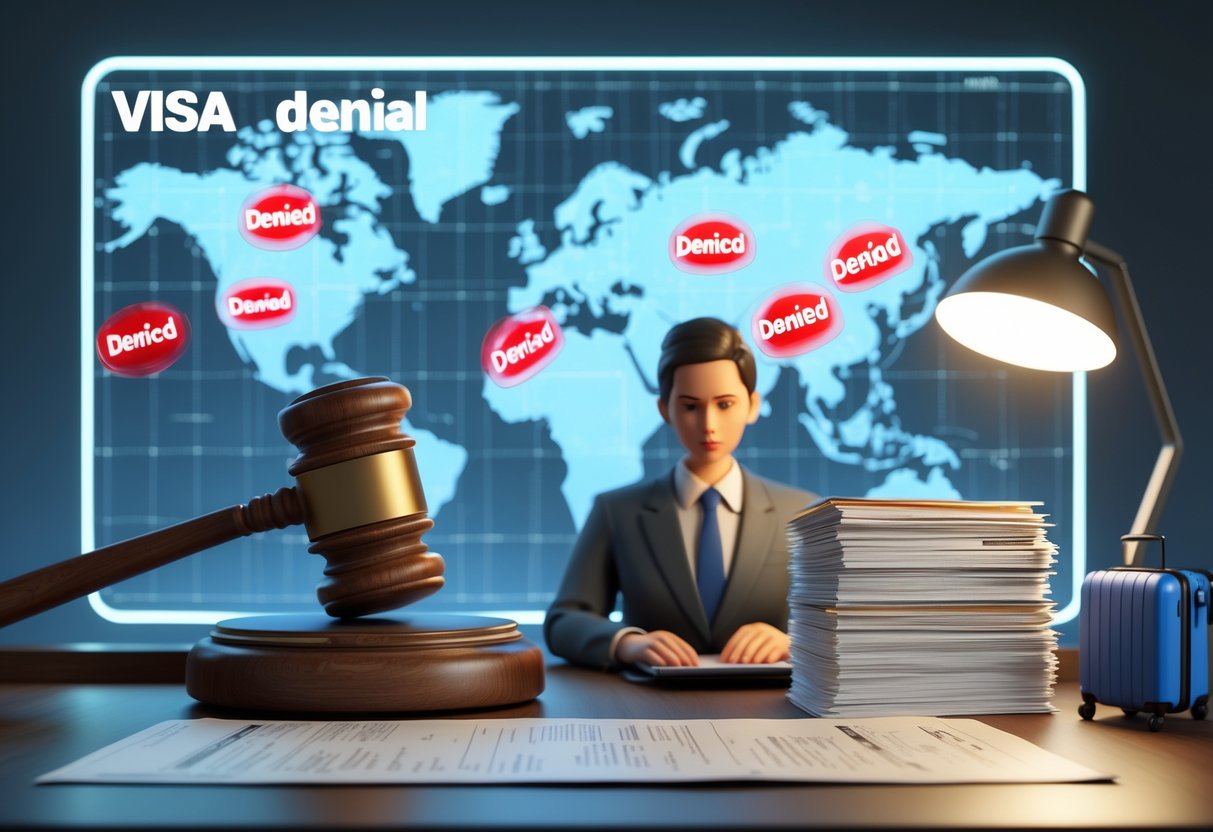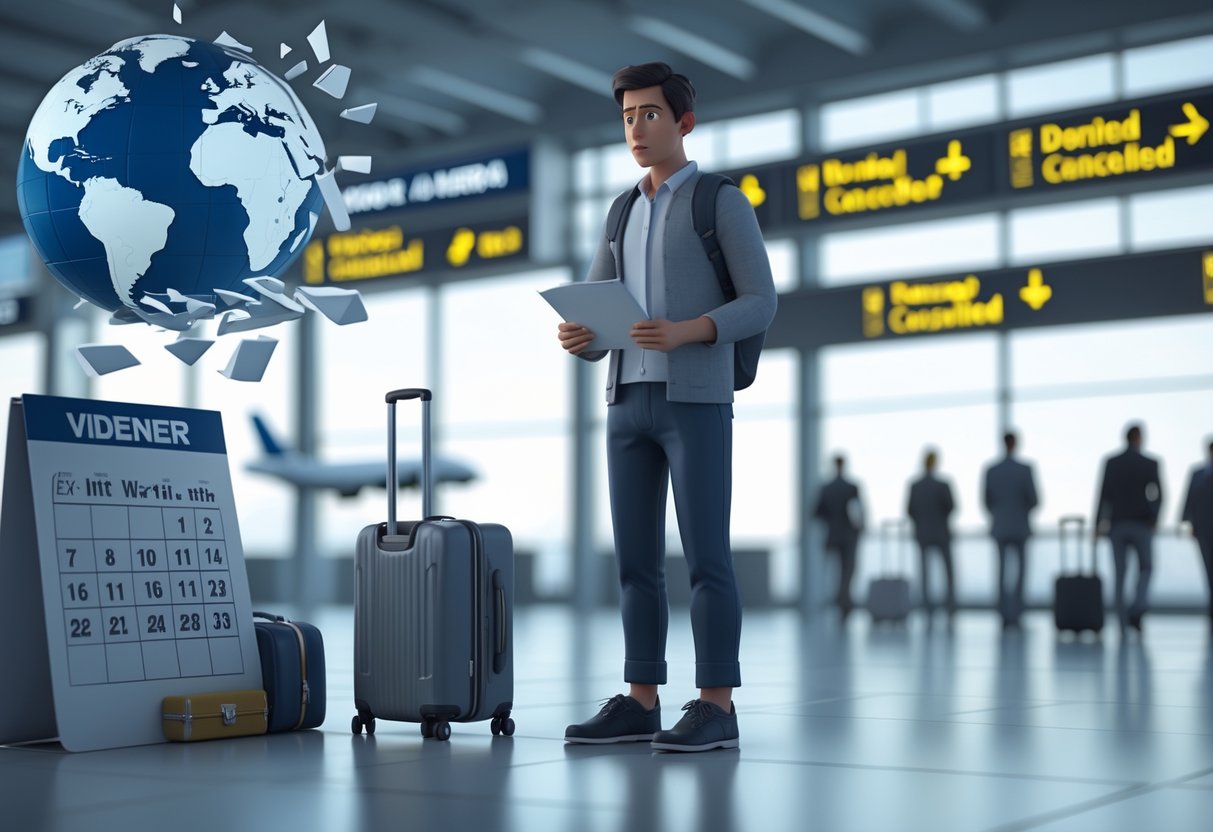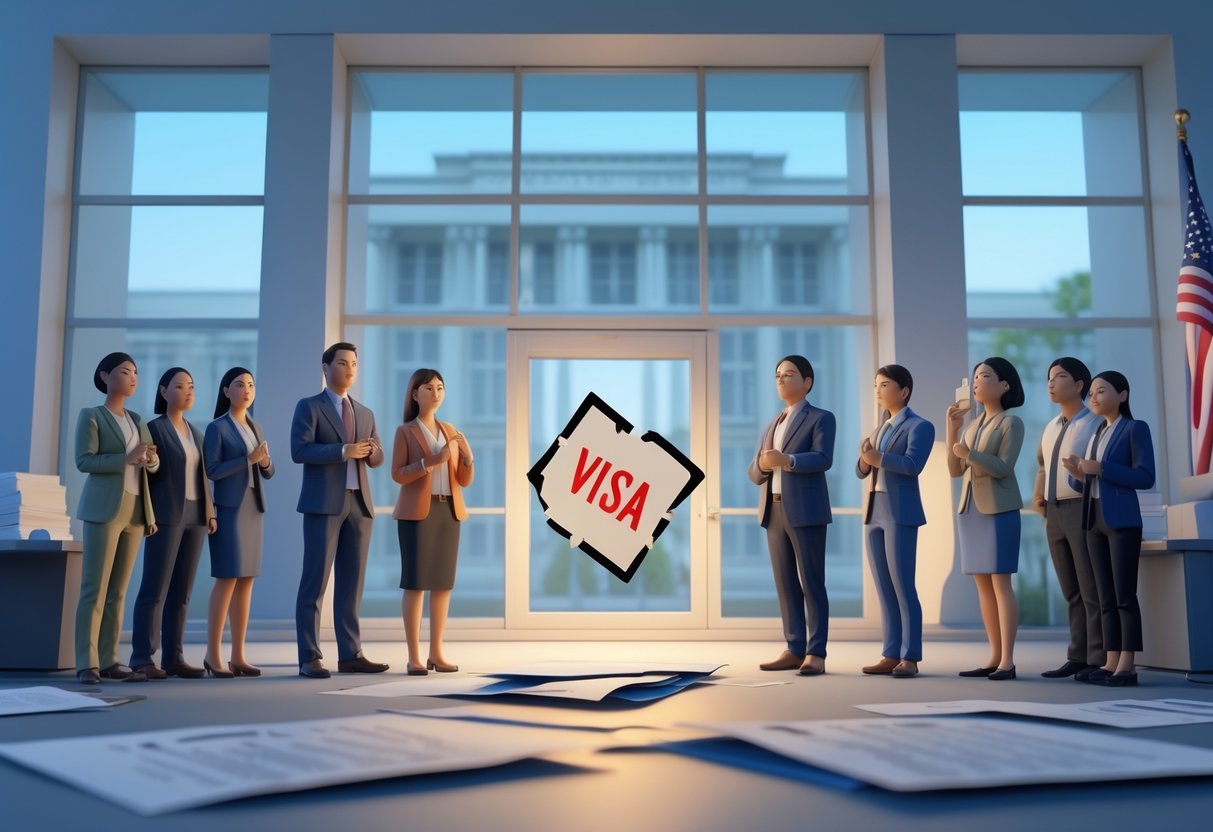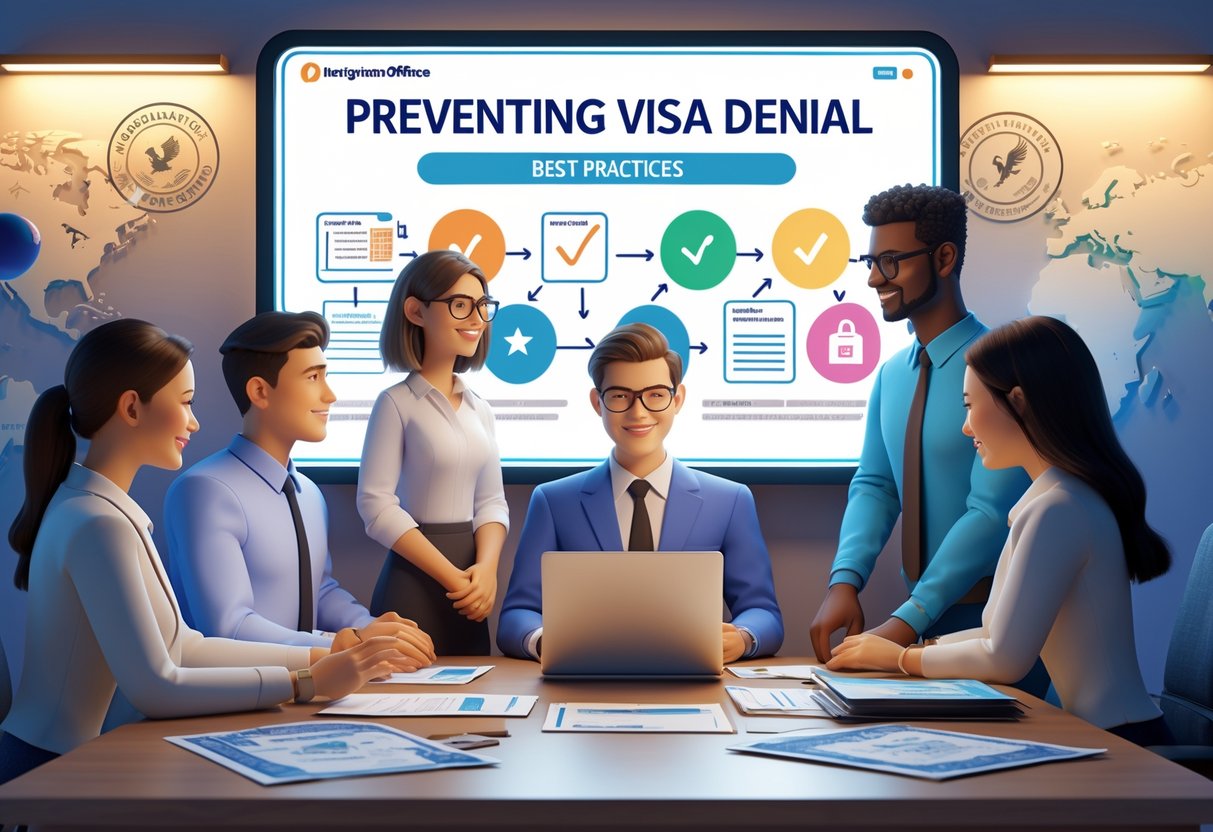Visa Denial Impact: Consequences, Next Steps, and Prevention
Updated On: November 13, 2025 by Aaron Connolly
Understanding Visa Denial
A visa denial happens when immigration officials look over your application and decide you don’t meet their legal requirements. People toss around words like “denial,” “refusal,” and “rejection,” but these actually mean different things in immigration.
Definition and Significance
When officials deny your visa, they’re saying you don’t reach the legal standards set out by immigration law. They check your documents and, if you fall short, you’re out of luck.
Some common reasons for denial:
- Wrong or missing info
- Weak ties to your home country
- Criminal record
- Past immigration problems
- Not enough financial proof
The denial leaves a permanent record in your file. That record can follow you for years, popping up every time you apply again.
Most countries ask you to come clean about any previous denials on new applications. If you lie about it, things can get ugly fast—sometimes you’ll get banned for life.
One denial doesn’t mean you’re doomed forever. It just makes things trickier. You’ll need to fix what went wrong before you try again.
Refusal Versus Rejection
People often use visa refusal and visa rejection like they’re the same thing as denial. Usually, they are, but some countries split hairs.
Here’s a quick breakdown:
| Term | Meaning | Record Impact |
|---|---|---|
| Denial/Refusal | Official “no” based on law | Permanent record |
| Rejection | Incomplete application returned | Might not leave a record |
| Withdrawal | You pull out before decision | Usually no negative record |
Administrative rejections pop up when your application’s incomplete. The office just sends it back without deciding. No real harm done most of the time.
If you withdraw your application before they decide, you dodge a negative record. Sometimes you realize you’re missing something and just want to back out.
Knowing these differences helps you figure out what’s actually on your record and how to plan your next move.
Primary Reasons for Visa Denial
Most visa rejections come from missing paperwork, eligibility gaps, or past immigration slip-ups. These issues often happen because of small mistakes that people could avoid with better prep.
Incomplete Applications
Tiny errors on your visa application can get you rejected on the spot. Maybe you leave a field blank, misspell your name, or mess up your passport number.
A lot of applicants trip up because their info doesn’t match across documents. Your name has to be spelled exactly the same everywhere—passport, forms, supporting docs.
Missing a required document is another big one. Each visa asks for different stuff:
- Tourist visas: Travel plans, hotel bookings, bank statements
- Student visas: Acceptance letters, proof of funds, transcripts
- Work visas: Job offer, sponsor letters, qualifications
If you use old forms, you could get rejected too. Immigration offices update their paperwork pretty often, so always grab the latest version online.
Double-checking everything before you hit submit can save you a ton of hassle and money.
Eligibility Issues
If you don’t meet the basics for your visa, you’re getting denied. Visa applicants have to prove they actually qualify.
Not enough money is a big reason people get turned away. You need to show you can pay for your whole trip—flights, hotels, food, whatever. Officers want to see steady income in your bank statements, not just a sudden deposit.
For temporary visas, you have to convince them you’ll come back home. That means showing strong ties:
- A steady job (with a letter saying you’ll come back)
- Owning or renting a place long-term
- Family who depend on you
- School commitments
Students and workers sometimes fail because their qualifications don’t match up. Schools and employers need to confirm you’re really eligible before you even apply.
Document Problems
If you give false info or fake documents, you’ll get banned for good. That covers fake bank statements, forged letters, or lying in your interview.
Authentication issues are sneaky. Some countries need official translations, apostille stamps, or embassy certification. Check the rules for your country early.
Bad document quality can tank your application, too:
| Document Type | Common Issues |
|---|---|
| Bank statements | Unofficial, altered amounts |
| Letters | No letterhead, unsigned |
| Photos | Wrong size, blurry, old |
| Certificates | Not certified, expired |
We really think it’s worth it to get your documents professionally prepped and certified. It might cost more, but it saves you from expensive mistakes.
Immigration Violations
If you’ve broken immigration rules before, getting a visa later is super tough. Overstaying, working illegally, or sneaking in will haunt your record.
Criminal history can be a dealbreaker, depending on the country and the crime. Even small offenses can cause trouble, and big ones can get you banned for life.
Health issues come up too—like contagious diseases or mental health problems that affect your behavior. Some places ask for a medical check before they’ll approve you.
Security concerns are another hurdle. If you’ve visited certain countries, worked in sensitive fields, or have family ties to restricted groups, you’ll face extra screening.
It’s always better to be honest about your past. Officers have access to huge databases, so hiding stuff usually backfires.
Legal Grounds and Policies

Visa denials come straight from legal rules that immigration authorities have to follow. The Immigration and Nationality Act (INA) spells out the main reasons for refusal, and broader immigration law sets the ground rules for how everything works.
Key Provisions in the INA
The Immigration and Nationality Act lays down the main legal framework for visa denials in the US. Section 212(a) lists the big reasons you can get refused.
Health-related grounds cover contagious diseases and mental disorders that could put people at risk. Applicants have to do medical exams to prove they’re not a threat.
Criminal grounds include all sorts of crimes—stuff like moral turpitude, drug violations, and having multiple convictions. Even small crimes can sometimes get you denied.
Security-related rules focus on terrorism, spying, or anything that might threaten national security. Officers do background checks to see if you’re risky.
Economic grounds look at whether you might end up needing government help. Officers check your finances and job prospects.
Section 214(b) is a big one for temporary visas. It says you have to prove you’ll go home after your visit.
Role of Immigration Law
Immigration law gives the bigger picture for how visa decisions get made and reviewed. These laws set the rules for due process and how you can appeal if you’re denied.
Administrative procedures tell officers how to judge applications. They can’t just say no for no reason—they need to back it up with real evidence.
Burden of proof means it’s on you, the applicant, to show you qualify. This comes up a lot with visitor visas, where you have to prove you’ll return home.
Waivers sometimes let people get around certain grounds of inadmissibility. If you meet the right criteria, you can get a second chance.
Appeal rights depend on the visa and the reason for denial. Some cases go to immigration courts, others just get a quick review.
The law also sets time limits for things like how long you have to wait before you can reapply.
Types of Visas Affected
Visa denials hit differently depending on whether you’re after permanent residence or just a temporary visit. Immigrant visas mean longer waits and tougher checks, while nonimmigrant visas can mess up your travel plans right away and make future applications harder.
Immigrant Visa Consequences
Immigrant visa denials sting the most in the long run. These applications are for permanent residence, so officials get extra careful.
Family-based immigrant visas get a lot of extra questions after a denial. Officers might dig into your marriage or relationship, asking for lots of proof that it’s real.
Employment-based immigrant visas bring different headaches. Your employer might just give up and hire someone else if things drag on too long.
A denied immigrant visa leaves a permanent record in the system. Any future applications, even for tourist visas, get scrutinized more closely.
Here’s what you might face:
- Longer waits (sometimes a year or two more)
- More paperwork
- You might need a lawyer
- Possible bans from immigrating in the future
Nonimmigrant Visa Challenges
Nonimmigrant visa denials mess up your travel right away, but you can usually fix things faster. Tourist, business, and work visas all have their own issues after a denial.
Tourist visas (B-2) get tricky because officers might assume you want to stay forever. Proving you’re just visiting gets harder.
Business visas (B-1) have similar problems, plus officers might worry you’ll work illegally.
L visas for company transfers are tough if you get denied. Companies don’t like to wait around, so you might lose out on promotions or get reassigned.
Work visas can get messy if your sponsor backs out after a denial. Some companies just move on instead of fighting the decision.
After a nonimmigrant visa denial, you’ll need to provide even stronger evidence that you’ll return home and that your travel is legit.
Impacts on Future Visa Applications
A visa denial sticks with you for good. Immigration officials will always see your past refusals, so your next applications might get more scrutiny.
Repeat Application Considerations
When you reapply after a denial, immigration officers want to see what you did to fix the original problem. Every new application needs to directly address why you got refused last time.
It’s usually smart to wait at least three months before trying again. That gives you time to gather the right documents and actually solve the problem. Rushing back in almost always leads to another denial.
Here’s what matters when you reapply:
• Addressing the problem – Show exactly how you fixed what went wrong
• New evidence – Bring in documents you didn’t have before
• Updates in your life – Maybe you got a new job, built up your savings, or have better travel history
• Honesty – Always admit to past denials when asked
Officers look for real improvements. Sending in the same stuff with tiny tweaks usually won’t cut it.
Refusal Stamps and Records
Visa refusal stamps leave a mark in your passport and on your digital immigration records. Border officials everywhere—not just in the country that turned down your application—can see these stamps.
Physical refusal stamps show up in your passport and you can’t erase them. Some countries use a separate page for these, but others stamp right over your visa application stickers.
Digital records live in immigration databases for years, sometimes forever. Countries trade this information through international systems, so a refusal in one place might cause problems somewhere else.
The type of refusal shapes your next steps:
• Document issues – You can usually fix these with better paperwork.
• Financial concerns – You’ll need to prove your finances have improved.
• Criminal history – This brings long-term headaches for most visa types.
• Immigration violations – You could face multi-year bans from certain countries.
Keep detailed notes about why you got refused and what you’ve done to fix those issues.
Consequences for Travel and Immigration Plans

A visa denial throws up instant roadblocks, not just for your current trip but for years ahead. It can block you from re-entering countries and invites extra scrutiny from immigration officials everywhere.
Barriers to Reentry
After a visa denial, officials flag your record for good. This makes future applications to the same country a lot tougher.
The US doesn’t mince words—previous rejections hurt your chances. Your denial sticks around for several years, depending on the country and why you were refused.
Immigration violations only make things worse. Criminal charges or fake documents pretty much guarantee more refusals.
You might still have options with different visa types. If you lost out on a tourist visa, you could still try for a student or work visa. Every new application means you have to explain what changed since your last denial.
If you’re thinking about reapplying, talking to a lawyer isn’t a bad idea. They can dig into your denial and help you figure out what to do next.
Travel Restrictions
Visa denials can kick you out of programs like the Visa Waiver Programme. Citizens from certain countries usually get 90 days in the US without a visa.
One denial and you’re out of the programme. You’ll have to go through the full visa process for any future US travel, which means more paperwork, time, and costs.
The denial can mess with your plans right away. Flights get canceled, hotel bookings go to waste, and travel insurance might not cover your losses.
Officials look even closer at your next application. They’ll ask for extra documents, take longer to decide, and might dig deeper into your background.
Some countries share denial info with each other. So, even trips to unrelated places can raise questions at the border.
Administrative Processing and Delays

When you can’t get a visa right away, your case goes into administrative processing under section 221(g) of the Immigration and Nationality Act (INA). This usually means one of two things: you either need to send more documents, or the government is running security checks behind the scenes.
The 221(g) Process
Administrative processing under INA section 221(g) isn’t a final denial—it’s a temporary refusal. Your case shows as “Refused” in the CEAC system until you meet the extra requirements.
Missing documents usually trigger this. Officials might ask for police records, court papers, or more evidence for your application. You’ll get a written list of what’s needed.
You’ve got one year to respond to document requests. Miss it, and you’ll have to start over.
Other triggers include:
- Your name matching a security database
- Certain jobs flagged by the Technology Alert List
- Extra screening based on your nationality
- Biometric matches that need double-checking
Some people get Form DS-5535, which asks for detailed background info. Filling it out can take a few weeks.
Administrative Reviews
Security clearance cases don’t need anything from you. Agencies handle these internal checks, and sometimes they drag on for weeks or months.
Give it at least 180 days before you ask about your status. Bugging them more often won’t help and could actually slow things down.
After 180 days, you can:
- Contact the consulate using their preferred method
- Check in every 30 days (not more)
- Ask for congressional help if it’s urgent or humanitarian
Applying for a new visa won’t speed things up. It usually just wastes your money and time.
Most cases in administrative processing get approved eventually. Delays often clear up in 6-12 months, but some complicated cases take longer.
Visa Interviews and Their Role

The visa interview is really where it all happens. Consular officers decide if you meet the entry requirements for the US, and they make quick calls based on your paperwork, your answers, and the overall vibe you give off.
Decision-Making by Consular Officers
Consular officers have a lot of say in your visa’s fate. They check if you fit the legal criteria and try to figure out if you’ll return home.
The officer looks over your DS-160 form, all your supporting docs, and your travel history before you even sit down. AI screening already flags possible issues before you reach the window, so the officer focuses on those concerns.
During the interview, they want your answers to line up with your application. They’ll look at:
- Why you want to visit the US
- Proof you’ll return home
- Your finances and travel plans
- Any previous immigration history
Section 214(b) denials happen when officers think you might overstay. This is the main reason tourists and students get denied.
Officers can approve, deny, or ask for more documents right there. Supervisors rarely overturn their calls.
Interview Strategies
If you want approval, prep is everything. Most people who succeed spend weeks gathering documents and practicing their answers.
Bring the originals for everything in your application. Upload digital copies 72 hours before, but keep the originals on hand.
Keep your answers short and honest. Officers prefer clear, direct responses over rambling stories. If you’re confused by a question, just ask for clarification.
Common preparation steps:
- Practice explaining your travel purpose
- Gather proof you’ll return home
- Prepare explanations for job or school gaps
- Review your travel history for the last two years
Show up early and look professional. First impressions count—they see hundreds of people every day.
If you get denied, ask which law section applies so you know why. You can reapply right away with new evidence, but make sure you fix the problem first.
Effect on U.S. Sponsors and Petitioners

When a visa application gets denied, it doesn’t just hit the applicant. U.S. sponsors and petitioners who filed the original paperwork feel the impact too. Sponsors still have ongoing responsibilities and have to figure out how to help their beneficiary move forward.
Sponsor Responsibilities
U.S. sponsors stay on the hook even after a visa denial. If you filed the original petition with USCIS, you’re still tied to any affidavit of support you signed.
Financial commitments don’t go away. If you signed Form I-864 as a sponsor, denial doesn’t free you. The affidavit sticks until certain conditions are met.
Petition validity doesn’t vanish. A denial doesn’t automatically kill the approved USCIS petition. Your I-130 or I-140 usually stays active, so the beneficiary can try again.
You might need to submit new paperwork. Depending on why the visa was denied, you may have to update financial documents, employment letters, or provide more evidence. USCIS could ask for fresh sponsor info if the beneficiary reapplies.
Some sponsors think denial ends their duties. That’s not true. Your legal obligations last until the visa is issued or the petition expires.
Communication and Updates
After a denial, good communication between sponsors and beneficiaries is key. You’ll need to plan your next move together and support each other through any reapplication.
Know exactly why the visa was denied. The consular officer gives specific reasons. Work with your beneficiary to understand these and gather what’s needed.
Time your reapplication right. For denials under INA section 214(b), you need real changes in circumstances before trying again. Help your beneficiary figure out what needs to change and when to reapply.
Stay on top of your sponsor paperwork. If the beneficiary reapplies, you might need to send in new tax returns, job letters, or bank statements. Keep these updated and ready.
Consider legal help. Tough denials might need an immigration attorney. Many sponsors find it’s easier with professional guidance.
Keep talking so everyone knows what’s happening and what needs to be done next.
Remedies, Appeals, and Waivers

A visa denial isn’t always the end. You’ve got a few options. Most people go for reapplication with better evidence, but sometimes you can appeal or ask for a waiver.
Appeal and Reapplication Options
Most visa denials can’t be appealed directly, especially if you’re dealing with a nonimmigrant visa refused under Section 214(b).
Reapplication is usually your only shot. File a new application, but make sure you’ve fixed what went wrong last time.
For immigrant visas, you might get to appeal using Form I-290B. Check your denial letter to see if this applies.
Deadlines matter. Appeals have strict time limits. Miss them, and you’re out of luck.
If your case is complicated, consider hiring a lawyer. Immigration attorneys know what works for different denial reasons.
Waivers of Ineligibility
Waivers ask officials to forgive certain problems in your case. They’re special requests for exceptions.
USCIS has to explain why they deny a waiver. Officers weigh the negatives against the positives in your situation.
Typical waiver types cover criminal records, health issues, or past immigration violations. Each one has its own rules.
If your waiver gets denied, you might be able to appeal, depending on the situation. Some waivers allow appeals, while others only let you file a motion to reopen or reconsider.
Form I-290B is the main form for waiver appeals and motions. It gives you another chance to submit new evidence or arguments.
Emotional and Financial Impact

Getting denied hurts, both emotionally and financially. Visa applicants often feel crushed and lose money they can’t get back.
Handling Disappointment
A visa denial can really sting. Many people say reading that rejection letter is just brutal.
The emotional fallout goes deeper than disappointment. You might feel hopeless about your plans. It’s frustrating—what did you do wrong?
Common emotional responses:
- Feeling rejected or like you failed
- Anxiety about trying again
- Stress if you’re separated from family
- Worrying about future travel
These reactions are totally normal. Lots of people go through this after a denial.
The psychological impact can stick around for weeks or months. Some folks get anxious about applying in the future. Others just lose confidence in traveling at all.
Quick tip: Talk to friends or family who’ve been through this. Their support really helps you get through it.
Lost Fees and Costs
Visa denials hit your wallet hard, and you won’t get that money back. Application fees alone can run into the hundreds of pounds, depending on which visa you’re after.
Typical costs lost after denial:
- Visa application fees: £95-£1,500
- Legal consultation fees: £200-£500 per hour
- Document translation costs: £50-£200
- Medical examination fees: £100-£300
- Travel to embassy appointments: £20-£200
Each time you reapply, the financial burden just gets heavier. Some people end up spending thousands after trying again and again.
Additional hidden costs:
- Lost deposits on flights or accommodation
- Missed work for embassy appointments
- Repeated document fees for new applications
Some families spend their savings chasing approvals, but still don’t succeed. Set a budget for yourself before you even start.
Losing this money can really strain your finances for months. Plenty of applicants admit they’ve had to put off big purchases or delay life plans because of these costs.
Best Practices to Prevent Visa Denial

Pulling your paperwork together and prepping for interviews are key steps if you want to avoid visa rejection. Sometimes, legal help makes a huge difference in complex cases.
Accurate Documentation
Most visa denials happen because of missing or incorrect paperwork. We need to gather every document that proves our qualifications and our ties to home.
Essential documents include:
- Valid passport with at least six months validity
- Completed visa application form
- Recent passport photos
- Bank statements showing financial stability
- Employment letter or proof of income
- Travel itinerary and accommodation bookings
Proof of finances is a big deal. We have to show we can pay for the trip without working illegally. Bank statements from the last three to six months usually work best.
If we’re applying for work or study visas, we need extra paperwork—job offers, education certificates, and sponsor letters. Each one has to be current and legit.
Common documentation mistakes:
- Submitting expired documents
- Providing unclear photocopies
- Missing translations for foreign documents
- Inconsistent information across forms
Double-checking every form before you submit is a must. Even a tiny mistake can get you rejected on the spot.
Preparation for Interviews
The visa interview gives us a chance to show we’re genuine. Good preparation helps us answer questions with confidence.
Look up common interview questions for your visa type. Practice talking about your travel purpose, how long you’ll stay, and your plans to return. Speak honestly about your situation.
Key interview tips:
- Arrive early and dress professionally
- Bring organised documents in a folder
- Answer only what’s asked
- Stay calm and polite throughout
Immigration officers want to see that we’ll return home. We should show strong ties like family, a steady job, or property. Mention specific reasons you have to come back.
Don’t recite memorised answers—they sound fake. Honest, natural responses work better. If you don’t get a question, just ask them to clarify.
Body language counts too. Make eye contact and try not to fidget. Confidence helps show you’ve got nothing to hide.
Legal Assistance
Some visa applications get complicated fast, and professional help can really pay off. Immigration lawyers know the current laws and can spot trouble before you submit.
Legal help makes a big difference if you’re applying for business visas, family reunification, or have previous denials. Lawyers can review your application and tell you what to fix.
When to consider legal help:
- Previous visa denials
- Complex immigration history
- Business or investment visas
- Unusual circumstances
Professional consultants know the requirements for different countries. They’ll help you gather the right paperwork and prep for interviews. Sometimes, this investment saves you time and prevents expensive mistakes.
Some lawyers offer free consultations to check your case. Pick someone licensed, with good reviews and the right experience.
You probably don’t need legal help for a basic tourist visa. But for anything important, professional advice can boost your approval odds.
Frequently Asked Questions

People who get denied visas usually have the same questions. They want to know why they were rejected and how to improve their chances next time. Timing, specific refusal reasons, and how denials affect future applications come up a lot.
How can I find out the specific reasons for my visa application being rejected?
When a consular officer denies your visa, they’ll tell you which law section applies to your case. This gives you the main legal reason.
You’ll get a written notice that explains why you were denied. Most often, it’s Section 214(b), which means you didn’t prove strong enough ties to your home country.
If you want more details, you can file a Freedom of Information Act (FOIA) request. That can reveal extra information about their decision.
Sometimes, consular officers give a quick verbal explanation during the interview. If you get feedback, jot down notes about what you need to fix.
What steps should I take to address a 214(b) visa refusal before reapplying?
A 214(b) denial means you didn’t convince them you’ll return home after your trip. You need to show stronger ties before trying again.
Gather better evidence—job letters, property paperwork, family responsibilities, or proof you’re in school.
Wait until your situation actually changes before reapplying. Sending in the same application with tiny tweaks usually gets you nowhere.
Think about getting a better job, enrolling in school, or making other real-life changes that prove you’ll come back. Make sure you document these changes well.
Look over your old application for mistakes or inconsistencies. All your dates, addresses, and personal info should match up next time.
Is there a limit to the number of times I can reapply after my visa has been refused?
There’s no law that limits how many times you can reapply for a US visa. You can apply as often as you want.
But if you keep applying without fixing the original issue, you’ll probably just get rejected again. Each denial can make the next one tougher.
Consular officers see your whole application history. If you reapply too quickly, it looks like you’re not taking their concerns seriously.
It’s better to wait until you have real new evidence or a changed situation. That shows you get why you were denied and have done something about it.
Will being denied a visa under 214(b) negatively affect my future visa applications?
A 214(b) denial doesn’t block you from getting a US visa forever. The refusal is based on your current situation, which can change.
Future officers will look at your denial history, but it’s not an automatic no. They care more about whether you fixed the original problem.
Always be honest about past denials. Lying can get you banned for misrepresentation.
If you build stronger ties to your home country and bring better proof, you can overcome a 214(b) denial. Loads of people get approved after a second or third try.
If my visa application has been turned down, how soon am I allowed to reapply?
You can reapply right after a denial—there’s no official waiting period for most refusals.
But if you apply again without fixing the denial reasons, you’ll probably get rejected. Officers expect to see real changes.
Most experts say it’s smart to wait at least 3-6 months before trying again. That gives you time to improve your situation and gather stronger evidence.
Use that time to address the weak spots in your application. Get a better job, save more money, or strengthen your ties at home.
What are the common factors that could lead to a visa application being declined?
Most people get their tourist or student visa denied because they can’t show strong enough ties to their home country. Maybe the job prospects look shaky, the financial situation isn’t great, or future plans just seem a bit vague (here’s a look at that).
If your application documents don’t match up, that’s a red flag. Officers check dates, addresses, and personal details, and they’ll notice if something doesn’t add up.
A poor interview can really hurt your chances. If you’re nervous, your answers are unclear, or you can’t explain your travel plans, it just raises more questions.
Money issues also make a big difference. If you can’t prove you have enough funds for your trip or show a steady income, officers might assume you can’t afford the visit without working illegally.
If you’ve overstayed a visa before or worked without permission, you’ll face big hurdles next time. Criminal history or any security concerns make approvals even tougher.

